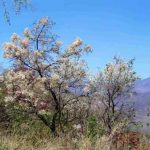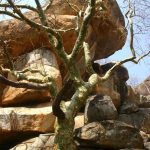TREE LIFE
December 1984
FORTHCOMING CALENDAR
Tuesday December 4th : Botanic Garden Walk. Meet in the Car Park at 1645 for 1700 hours.
Sunday December 16th : No outing as such, but members and friends are all invited for a pre Christmas gathering to bring their lunch to the Haxen’s home “The Shambles” at 27 Helensvale Road, Helensvale in Borrowdale. Tea and coffee will be on the go and Ma Hax will probably have engineered a few Christmas pies, etc., besides this and looking at the woodland on the property we want to show you a recently discovered colony of Ensettes in a delightful gorge nearby. Come any time after 1000 hours.
MATABELELAND NOTES
Our November outing was cancelled, owing to continuous and welcome rain. In fact at present Bulaway leads the rest of the country in the rainfall figures. This can’t happen very often. So we will have the same intended venue for December.
Sunday, December 2nd : 0830. Meet at the Junction of Circular Drive and Old Gwanda Road.
CHEGUTU NOTE
Sunday December 2nd : The venue is Chikanga Farm, Gadzema, our hosts Mr. and Mrs. Terry Fynn. On the Biri River Terry has a series of weirs and the scenery is very pretty – similar to but on a smaller scale than the Ijapo stretch of the Umfuli. A brief recce yielded Pteleopsis anisoptera in full flower, quite a sight, with the remains of last year’s seeds giving the solution to the identification puzzle. Terry has a good road all along the river bank with one especially good picnic spot, and there are comfortable walks all round. Chikanga is 20 km from Chegutu along the new Chegutu/ Chinhoyi road, and it is signposted. The river is quite a way from the house so we will stop at the house for a quick cuppa and comfort stop meeting there at 0930 hours. From the house the route will also be signposted.
-Ann Bianchi
BOTANIC GARDEN WALK TUESDAY 6TH NOVEMBER 1984
This was well and truly rained out. My suggestion that this would create the ideal atmosphere to look at the Rainforest Section met with no enthusiasm at all.
OUTING TO NEW EREWHON FARM, ARCTURUS, SUNDAY 18TH NOVEMBER 1984
A pleasing number of cars made the short trip through the newly green countryside to New Erewhon, situated at one end of a ridge. After introducing our host and hostess, Leily and Mary Henriques, the party was led up through the rock garden behind the house past a planted Dais cotinifolia into the shade of some elegant mountain “acacias”, Brachystegia glaucescens. A Faurea speciosa in new leaf fooled quite a few people into thinking this was a Combretum molle, as a result of the leaf colour and the slightly velvety texture. The alternate, as opposed to opposite leaves and deeply fissured rough bark soon proved the error.
A little higher up the kopje the highlight of the day was located. This was Philippia, which is a member of the ERICACEAE, which was here as a small community of true trees. The largest was perhaps 4 m tall with a trunk 10 to 15 cm in diameter, which is perhaps remarkable for the family which is, I believe, better known for its shrubby, knee high bushes. In Zimbabwe Philippia is more commonly seen on the mountains of Inyanga rather than on the kopjes of Harare, although the distribution map in ‘Trees of Southern Africa; certainly suggest that both local species will extend as far west as Harare. The two species are P. benguellensis and P. hexandra, but without flowers we were unable to determine which species this was. Both species have tiny needle like leaves, up to 2 mm long crowded along the branches. Subsequent identification at the Herbarium showed this to be P. hexandra.
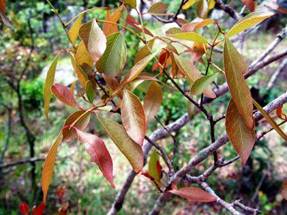
Pleurostylia africana. Photo: Rob Burrett. Source: Flora of Zimbabwe
Further up the path was Osyris lanceolata, often a shrubby bush, but here decidedly a small tree. The leaves are alternately arranged and are a blue green to olive green colour being somewhat rounded in shape with a sharp tip. It belongs to the family SANTALACEAE, Sandalwood. Next to this was a small specimen of Pleurostylia africana, which I confess, I confused with Tarenna neurophylla because of the similar lanceolate leaf and droopy appearance. The obvious difference, of course, is the presence of an inter petiolar stipule on Tarenna because it is in the RUBIACEAE. The RUBIACEAE also always have an entire margin, Pleurostylia may have a scalloped edge.
A couple of steps further along was a Rhoicissus tridentata busily clambering over the other bushes. Nothing unusual in that, except that this specimen tended to have simple leaves as well as the usual trifoliate leaves. Indeed, one branch bore a trifoliate leaf, one leaf split in two and then also a simple leaf!!
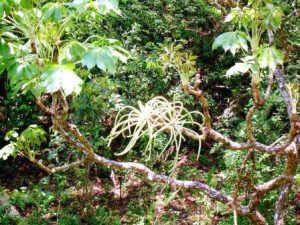
Cussonia arborea. Photo: Bart Wursten. Source: Flora of Zimbabwe
Overhead were some Cussonia arborea coming into new leaf but resplendent in flower, those pale yellow octopi or medusas are quite distinctive. Still on the way up was a large specimen of Euclea natalensis. Perhaps its good size had a little to do with the fact that it looked far less ‘dirty’ than is usual.
Earlier I spoke of the ‘highlight’ of the day, but on reflection, I think that Acacia sieberiana at the top of the kopje was perhaps a more worthy recipient of this honour. The spread of this old fellow was vast and three volunteers proved that the circumference of the trunk was three arm spans, also known as ‘Meg-units’. Most remarkable though was the community of plant species enjoying protection, and probably nitrogen rich soil, under the acacia’s spreading branches. These included, Canthium lactescens, the terminal buds of which obliged us by producing a drop of ‘milk’ when squeezed. Pavetta gardeniifolia was present in the shade, whereas on the perimeter Pavetta schumanniana was in flower. Both of these have black bacterial dots in the leaves which are seen when the leaf is held up to the light.
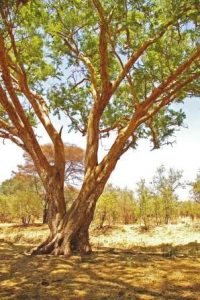
Acacia sieberiana. Photo: Meg Coates Palgrave. Source: Flora of Zimbabwe
Young Celtis africana were coming up and caused a little confusion with the somewhat similar leaf shape of Grewia stolzii. Closer examination of the Grewia showed it was not Celtis but we had to wait for correct identification of G. stolzii. Maytenus undata was present, complete with the musty smelling underside to the leaf which we have learnt to look out for over the last couple of months. During the day we were also able to compare Maytenus senegalensis and Maytenus heterophylla. There was a large specimen of Pterolobium stellatum and a Haemanthus multiflorus, fireball or pin cushion, in flower, to delight the eye. There was also a rather bent Pappea capensis, as well as a Clerodendrum myricoides. Elsewhere we also saw and smelt Clerodendrum wildii with its purple petiole, and C. glabrum, with leaves coming out in whorls of three.
From the big tree we went out to the beacon at the summit and with the absence of any haze were able to enjoy a magnificent view for many miles in all directions. The small tree in bud just below the beacon was later identified as Tricalysia angolensis. It was heavily laden with flower buds about to burst open.
The party was then led to the other end of the ridge and there were rewarded by the sight of a colony of Ochna puberula in fruit. Well, the fruit itself is nothing more than a black tick of a berry but sits in a bright pink calyx which is what really steals the show. Later in the afternoon we were to see O. schweinfurthiana the fruits of which were not greatly different. The leaves are much larger, but the other point is that the bark of this latter tree is longitudinally and latitudinally fissured into small rectangles which are pretty obvious once one knows what to look for. The bark of O. pulchra, the other common Ochna, flakes off completely to reveal the smooth under bark, so one should be able to separate all three on the basis of bark alone, ho ho!
Also at the end of this ridge were a few specimens of Hymenodictyon floribundum, the fire bush. Readers are entreated to look at a photo illustration No. 285 in ‘Trees of Southern Africa’ to see what this looks like when it is at its best. The only red we saw on these were the brand new leaves and significantly, the fresh interpetiolar stipules, actually more a voluptuous pink.
En route back to the house we came past Protea welwitschii, the one with long thin furry leaves, and once again we were able to compare later in the day, P. gaguedi, the one with long thin smooth leaves, and P. angolensis, the one with the broad, roundish, smooth leaves with pink “petioles”.
Lunch time found hot tired groups dotted about in the cool shade and on green lawns in the Henriques most congenial garden.
For the afternoon walk the members, replete with picnic lunch found it less strenuous to take a stroll over level ground without climbing. This walk took us first to fairly young Ficus thonningii which almost appeared to be standing on stilt roots. An arm’s length away was a small Bequaertiodendron magalismontanum, which one might expect more usually to see near water. This appeared to be a small ant hill so this possibly explained its presence here.
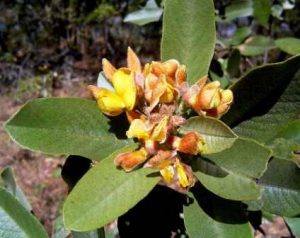
Eriosema elipticum. Photo: Bart Wursten. Source: Flora of Zimbabwe
The route took us through a mixed woodland where a number of Pittosporum viridiflorum were seen. The lenticels on the grey bark were noted. Dodonaea viscosa were numerous and although no fruit or flowers were seen they were soon identified by the leaf size shape and colour but especially by the way the leaves tend to reach upwards for the sky.
On our walk past the dam we saw Flacourtia indica in flower. A common shrub/tree we often see and invariably politely ignore was given more attention and was later identified as Eriosema elipticum. The simple leaf is significant. Another plant often ignored, this time had ‘tree status’ and was later identified as Aeschynomene trichocarpa. A Vernonia collected by Brian Best was identified at the Herbarium as V. amygdalina. The usual identification method involves looking through a hand lens for the presence or otherwise of hairs on the ‘inferior ovary of the floret’. In so doing, Brian observed a more obvious difference between the flowers of V. amygdalina and V. colorata, namely, that the bracts around the composite flower are round in shape on V. amygdalina and pointed on V. colorata. We wonder whether this might be a new simple method of identifying the various species?
Our warm thanks go to Leily and Mary Henriques for letting us invade their charming house and property and for letting our members have some raw material from Uapaca kirkiana and Strychnos spinosa.
-J.P. Haxen
AYRSHIRE A.G.M. NKODZWI FARM 11TH NOVEMBER 1984
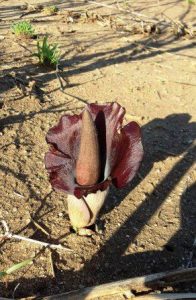
Amorphophallus abyssinicus. Photo: Bart Wursten. Source: Flora of Zimbabwe
With an Ayrshire morning tea one does not mind missing breakfast and hitting the road early. We had also been rewarded by the drive through Pericopsis countryside, the smooth white bark on the sinuous trunks stands out in marked contrast to surrounding trees. The Duffield’s farm abound with interest, our last outing there was most rewarding. This time the trees were somewhat leafless and the pregnant clouds showed signs of labour as we scrambled up the hillside examining the wealth of bushmen paintings on the way. Having clambered past a furry leaved Ficus glumosa and climbed around a F. natalensis with its truncated leaf, we found a mystical rock art figure with a shock of hair in painted flight above the elongated figures. The aerie sensation was heightened by finding two ankle high blooms which combined the spender of Solomon in all his glory with the evil attraction of Endor’s witch The purple maroon spathe of this ‘lily of the field’ Amorphophallus abyssinicus, swells around part of the spadix and then opens out with a pleated margin. The genus contains some of the world’s largest spathes. On the top of the kopje we found three Commiphora species, C. mossambicense, just coming into leaf, C. mollis and the peeling bark C. marlothii. A new observation were the large numbers of C. marlothii with one of the Loranthaceae in the branches. Unlike most of these semi-parasites which erupt as sturdy yet brittle bushes from the host tree, this species hung down in loose curtains. We resolved to take more note of this family in future, for those who did not know the genus Loranthus does not exist in Zimbabwe any more, we now have a dozen or so genera instead. Diospyros natalensis and Erythroxylum emarginatum grew to large specimens amongst the rocks. We found both leaves and fruit of Monotes engleri but failed to find the tree itself. We descended the kopje by entering a cavern and wending our way through the heart of the rocks. No sooner had we emerged from the belly of the earth when the waters broke overhead and we were forced to explore a nearby grotto.
Having returned to the farmhouse and dried off we sat down to the Ayrshire AGM which included an excellent farmhouse lunch. We express our heartfelt thanks to the Ayrshire fold and especially the Duffields for their hospitality. Returning to Harare via Mutorashanga Pass we were struck by the beauty of the Acacia polyacantha in full white flower along the water courses and drainage lines around the Mazowe Valley.
-Kim ST.J. Damstra
ROOT NOTE : The Albizia species have come into flower in the past month We may recall that A. gummifera has a distinct shaving brush flower with one central white floret different from all the rest which have a lot of red in them. A similar central floret occurs in both A. versicolor and A. antunesiana although in each case it is white like all the rest and therefore is not as striking. We were surprised to find that each head of A. amara flowers generally has three of these central florets, it ranged from two to four in some heads, in this case they are pink in colour while the rest of the flower is creamy yellow. Most of the show in Albizia results from the numerous stamens and not from petals. Generally the stamens all stick out individually but in all of these central florets the leaves of the stamens are fused to form a tube. We had to take the head of A. schimperana apart to prove to ourselves that this also has three different florets a subtle difference in fusion. At Murial Mine we learned that A. tanganyicensis also has at least one different floret, not an easy discovery as the flowers were dead and scattered on the ground. These central florets are not easy to see on herbarium sheets and so they are not often mentioned, but if anyone finds similar central florets in other Albizia species or knows of a functional difference between the florets please let us know.
Kim ST.J. Damstra
ROOT NOTE : African Acacias are armed with spines or prickles. A. tortillis has both. Spines are modified stipules and are located at the nodes whereas prickles are superficial and arise below the nodes. Acacias with hooked prickles have straight spike, flowers, in contrast those with spines, which are usually straight, have globose or bobble flowers. The exception is A. albida, Faidherbia albida, with spines and spikes. As an aid to memory for the 15 species on the Mashonaland Field card :
“Erubs (arabs), nigres and poly’s galpin (galloping) goetz, as well as melliferous
Schweins have prickles; all the rest have spines.
-Dickie Groves
ROOT NOTE Einstein’s theory of relativity and Zimbabwean seasons have much in common. Both are difficult concepts for teachers and scholars alike, but once the latter is fully understood, relativity is child’s play. Trees are the unequivocal picture book symbol of the seasons. The commonest of Highveld trees are the msasa, Brachystegia spiciformis, and the munondo, Julbernardia , the month is obviously August. Autumn is symbolized by a tree aglow with flaming leaves, easily evoke autumn. By October the fresh green of spring defies the extended drought and November leads to a preoccupation with the summer vacation, heralded by long the September spectacle of scarlet flush. The bare boughs of winter are sandwiched between this and hot days around the pool. The closest a child can come to the legendary image of winter is on a sweltering December shopping day when windows are decorated in cotton wool, and bearded men, bundled up in burdensome clothing, perspire their way around the store. By January the cotton wool is replaced with signs of summer sales and the munondo is crowned with ripening fruit. D.H. Lawrence expressed the desire to “go south where there is no autumn” how wrong he was. In a mere six months we have had one fall, two winters, one autumn, two summers and a spring. In Zimbabwe relativity is a fact of life!
-Kim ST.J. Damstra
ROOT NOTE Taxonomy and pottery have as much in common as horticulture and painting. The latter pair appeals to the visual sense, the eye is drawn by the colour, the line and the texture to explore a landscaped garden or an oil painting. Leaves, like pots, are three dimensional objects which need to be touched and felt, rubbed and turned over; but unlike pots the full expression comes in the crushing of the leaf, the feel and sound as it breaks and the smell which results. Prevented from this fuller experience, a taxonomist in an interesting garden becomes like a potter on the opening night of a stimulating new exhibition; just watch the fists clench and unclench, the thumb as it roams across the tips of the other fingers, distracted in the restrained desire to lean over and feel the objects, to weigh them in the hands. Artists realize the danger of touching the works on display but understand the emotions; in order to compensate they put a glass in your hand as a displacement therapy and fill it with wine to dull the frustration. Botanists have not yet attained the higher plane of thought. Botanic gardens often instruct visitors not to pick leaves, but then they fail to provide suitable placebos. I have yet to meet a botanist who is able to roam in amongst unusual species and not yield to the over powering temptation provided. Fortunately curators understand this urge and turn a blind eye to such activities.
-Kim ST.J. Damstra
NOTE ADDED IN PRINT : Since the rushed writing of the newsletter there have been a number of corrections and interesting additions to the notes on New Erewhon. The Aeschynomene is in fact A. schliebenii and not A. trigonacarpa as stated. This was confirmed by Bob Drummond. There has also been much thought on the Phillipia which is reported above to be P. hexandra. The two species cannot be separated except on floral structure, which we do not have. Herbarium records reveal that the closest confirmed P. hexandra is on Wedza Mountain, whereas the nearest P. benguelensis is reported from Chinamora. Therefore it is possible that the specimens were of the latter species. Brian Best found a shrub which looked just like Lippia javanica but lacked the smell. This identified as Lantana scabra. A small Vernonia glaberrima was also collected, this is not a tree at all. An interesting find which emphasized the benefit of collection, even of the plants one thinks one knows, was a twining, virtually leafless, pale green parasite which I informed someone was dodder. Dodder belongs to the family CUSCUTACEAE which is situated near the CONVOLVULACEAE with Asteridae amongst the more advanced plants. I also remember telling someone that the LAURACEAE do tie together on vegetative characteristics, and that it was possible to have a mental image of this family as a whole. Both of these ideas are destroyed by the fact that this ‘dodder’ turned out to be Cassytha filiformis, a member of the primitive LAURACEAE. I do not yet know the differences between these two plants, but according to Cronquist : “It has sometimes been considered to form a separate family CASSYTHACEAE, but it is so similar to typical LAURACEAE in other features and its relationships are so clear that most authors keep it in the LAURACEAE. Unlike many other parasitic groups Cassytha has a normal, well developed embryo.” I am at a loss to the “other features” mentioned above.
-Kim ST.J. Damstra
-PHILIP HAXEN CHAIRMAN


